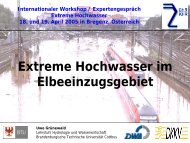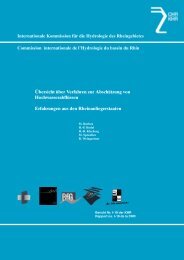ABSTRACTS 'Extreme Discharges' - CHR-KHR
ABSTRACTS 'Extreme Discharges' - CHR-KHR
ABSTRACTS 'Extreme Discharges' - CHR-KHR
Create successful ePaper yourself
Turn your PDF publications into a flip-book with our unique Google optimized e-Paper software.
Uncertainty in flood quantiles from basin and river models<br />
Ferdinand Diermanse<br />
Henk Ogink<br />
WL Delft Hydraulics<br />
P.O. Box 177, NL 2600 MH Delft, the Netherlands<br />
Hendrik Buiteveld, RIZA<br />
Institute for Inland Water Management and Waste Water Treatment (RIZA)<br />
P.O.Box 9072, NL 6800 ED Arnhem, the Netherlands<br />
ferdinand.diermanse@wldelft.nl<br />
henk.ogink@wldelft.nl<br />
h.buiteveld@riza.rws.minvenw.nl<br />
Introduction<br />
Without adequate flood defence structures, almost two-thirds of the Netherlands would be regularly flooded. To<br />
prevent floods by the sea, rivers and lakes, an extensive system of river dikes and coastal-defence has been constructed<br />
in the past. In the design of the dikes a safety level is defined of the order of 10 -3 to 10 -4 “failures” per<br />
year. This frequency is based on both the economic value of the protected area and the extent of the threat. Related<br />
to this safety level, the design of the dikes must be based on extreme hydraulic conditions, i.e. extreme<br />
water levels, wave heights or wave periods. In practice these conditions are often derived in statistical form<br />
where some type of extreme-value distribution function is fitted to observed data of extreme conditions. When<br />
extrapolating to extreme events with a frequency of exceedance of 10 -3 to 10 -4 per year, the statistical uncertainties<br />
inevitably are substantial.<br />
Extreme value analysis: traditional approach<br />
Most commonly statistical methods are used in extreme value analysis and a parameterised probability distribution<br />
function is fitted to a set of observed extremes of the target variable. The distribution provides a one to one<br />
relation between probabilities of (non)exceedence (which are equivalent to return periods) and the associated<br />
level of the target variable (e.g. peak discharges). This relation can then be used for the prediction of extremes<br />
for recurrence times that are far beyond the length of the data record. The popularity of such strictly statistical<br />
methods is mainly due to the fact that they are easy to apply. For design purposes along the river Rhine the frequency<br />
analysis of extreme discharges uses no less than five distribution functions: Gumbel, log-normal, Pearson-III,<br />
general Pareto and exponential. An averaging procedure is applied to obtain a unified result.<br />
The uncertainties in frequency analyses are generally expressed by confidence intervals. The traditional method<br />
to estimate these intervals is to assume a Gaussian shaped confidence band for the parameters of the distribution<br />
function. In this way the confidence intervals, or at least approximations, can be derived analytically. A problem<br />
with this assumption is that it sometimes results in suspiciously wide confidence intervals. Furthermore, confidence<br />
intervals can differ strongly for different distributions even if the goodness-of-fit is comparable. An example<br />
of this is shown in Figure 1 where two functions (general Pareto and exponential) are derived from a<br />
series of Peaks-Over-Threshold discharges for the Rhine at Lobith over the period 1901-2004. For a return period<br />
of 1,250 years (which is the design criterion along the non-tidal part of the Rhine in the Netherlands) the<br />
width of the confidence interval is 5,500 m 3 /s for the exponential distribution and 9,000 m 3 /s for the Pareto distribution.<br />
Since both underestimation and overestimation of flood dangers can prove to be very costly, these<br />
uncertainties are much larger than desired. Furthermore, these two numbers show that even the estimated uncertainties<br />
are highly uncertain!<br />
39





